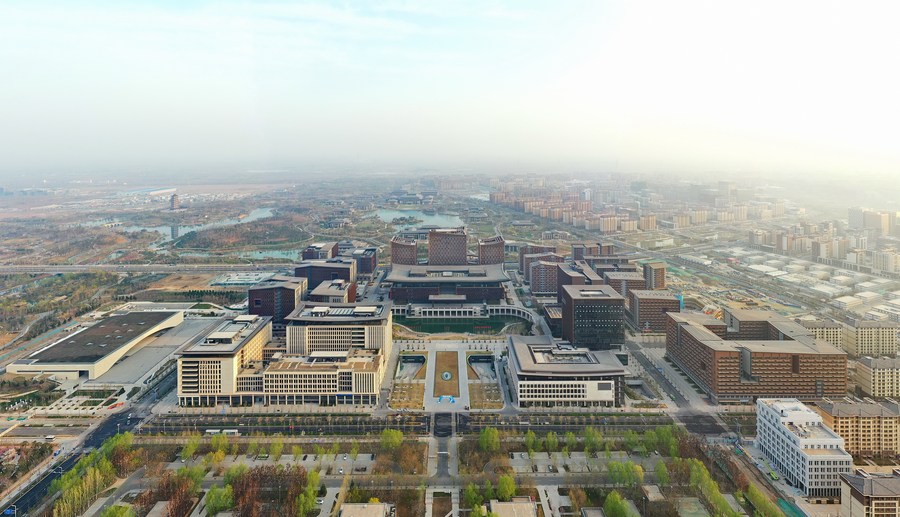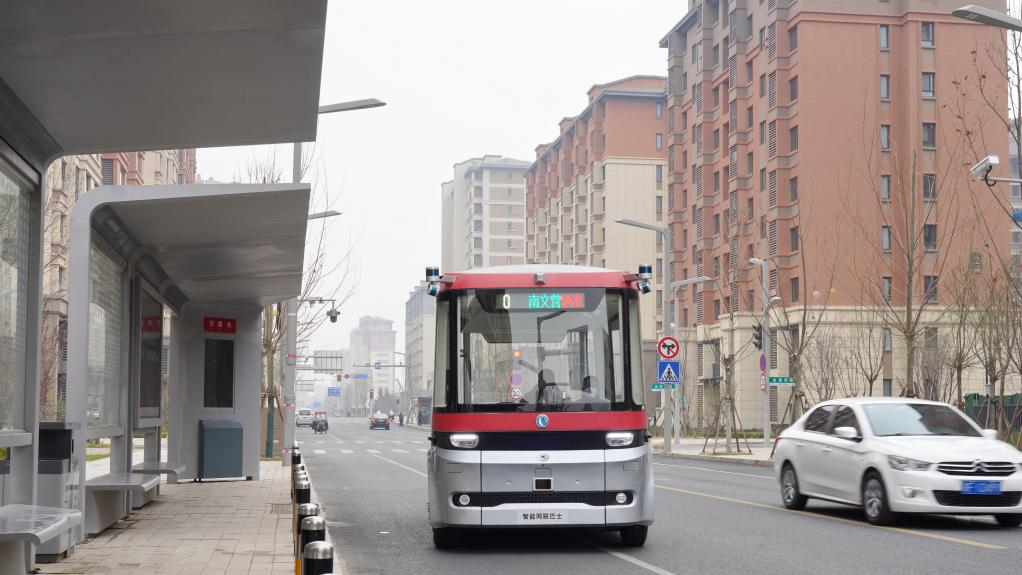
The business service center in Xiong'an New Area, north China's Hebei Province, March 31, 2023. /Xinhua
The business service center in Xiong'an New Area, north China's Hebei Province, March 31, 2023. /Xinhua
Editor's note: Qian Feng is a senior research fellow at the National Strategic Institute, Tsinghua University and Taihe Institute. The article reflects the author's opinions and not necessarily those of CGTN.
April 1 marks the sixth anniversary of the official establishment of the Xiong'an New Area. Six years ago, the Communist Party of China (CPC) Central Committee and the State Council issued a circular to establish the Xiong'an New Area, which is another new area of national significance after the Shenzhen Special Economic Zone and the Shanghai Pudong New Area, and has attracted great attention both at home and abroad.
Set up in six years, the urban framework of the Xiong'an New Area has been fully opened, the urban functions continuously improved, and the initial prototype of the city revealed. Important progress has been made in undertaking relocation, construction of key areas and major projects, and ecological and environmental protection. The area has its comprehensive carrying capacity, factor agglomeration capacity and self-development capacity, and is moving towards a new stage of leapfrog development. From here, the world can not only feel the pulse of China's high-quality development, but also see China in the future. As time goes by, the triple strategic significance of the Xiong'an New Area for China's development has become more and more apparent.
First of all, from the perspective of regional development, compared with the Yangtze River Delta region and the Pearl River Delta region, the long-term development of the Beijing-Tianjin-Hebei region is unbalanced. In terms of economic indicators such as per capita GDP, per capita local fiscal income, rural per capita net income, and social welfare indicators such as education and medical care, the gap between Hebei and Beijing and Tianjin is relatively prominent. The "big city disease" such as population expansion, traffic congestion and public resources shortages are prominent, especially in the capital Beijing. And its surrounding areas are too "thin," with obvious gaps.
Therefore, as the bearing place for Beijing's non-capital functions, the Xiong'an New Area can fully drive the development of less developed areas in Hebei and reshape the area development pattern, by absorbing and agglomerating innovation elements and resources, developing high-end and high-tech industries, building a modern industrial system with the coordination of the real economy, scientific and technological innovation, modern finance and human resources. This is exactly the original aspiration of building the Xiong'an New Area.
Second, from the perspective of national development, China has become the world's second largest economy after 40 years of development. At the same time, China's reform has entered a deep water zone, and the contradiction of deep-level development has become more prominent. For example, in the past development, some areas were seriously polluted, and some places relied heavily on real estate for development. The solution to these problems requires a greater determination by Chinese policymakers.

An intelligent connected bus runs on a road in Rongdong area of Xiong'an New Area, north China's Hebei Province, March 20, 2023. /Xinhua
An intelligent connected bus runs on a road in Rongdong area of Xiong'an New Area, north China's Hebei Province, March 20, 2023. /Xinhua
During the past six years, in the construction of Xiong'an New Area, China has continuously practiced the idea that clear waters and green mountains are as valuable as mountains of gold and silver, banned the development of backward industries, paid more attention to the happiness of people's lives, etc.
For example, according to the outline of the plan, new concepts such as green and low-carbon development and building sponge cities will also be fully implemented in the Xiong'an New Area. In the future, the Xiong'an New Area will be embedded in the blue-green interwoven ecological space, with the proportion of blue and green space at 70 percent.
Moreover, overlooking the map of China, Shenzhen, Pudong and Xiong'an respectively occupy the three dimensions of the south, central and north. It is expected to jointly promote China's overall balanced development in the future and change the current layout of China's economy which is "strong in the south and weak in the north." Xiong'an New Area has thus become a new fulcrum for China's development in the new era.
From the perspective of world development, the "world vision and international standards" emphasized by the construction of the Xiong'an New Area is to fully draw on the advanced international achievements in all aspects, integrate Chinese culture and new ideas, and make the city itself have international standards.
Although the Xiong'an New Area, along with the Shenzhen Special Economic Zone and the Pudong New Area, has three state-level new areas, its significance is even more important. The mission of the Shenzhen Special Economic Zone is to bring the world into China and integrate China into the world, and to act as a window and bridge. The most important role of the Pudong New Area is its financial development and internationalization.
The biggest difference between the Xiong'an New Area and the two special zones is that China's role in global development has changed. In particular, in the context of the continuous promotion of the Belt and Road Initiative, if China wants to become an innovative country and provide Chinese solutions for the world economy and global governance, the Xiong'an New Area must carry the mission of innovation and better benefit the world with the new standards that China explores in the development of new urban types.
There are reasons to expect that the exploration of the Xiong'an New Area will eventually be translated into a supply of global public goods and provide a vivid Chinese case for the realization of global sustainable development.
(If you want to contribute and have specific expertise, please contact us at opinions@cgtn.com. Follow @thouse_opinions on Twitter to discover the latest commentaries in the CGTN Opinion Section.)